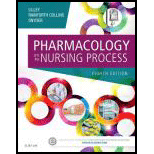
To Compare:
The terms “adverse drug event, adverse drug reaction, allergic reaction, idiosyncratic reaction, medical error and medication error related to drug therapy in the context of professional nursing practice.
Introduction:
Professional practice is defined as applying one’s knowledge in a specific profession. Professional practice in nursing means the way in which the nurses practice, communicate, cooperate and develop workwise for providing high quality care for those the organization is serving.
Explanation of Solution
Adverse drug event is a common term that includes all kinds of clinical problems associated with medication use, along with medication errors plus adverse drug reactions.
Adverse drug reaction can be defined as any harmful reaction which is caused by the use of medicinal product. The adverse drug reactions can be classified into six types based on dose, time, failure and withdrawal of the treatment. The two major types of adverse reactions are an allergic reaction and idiosyncratic reaction. This reaction may occur as a result of single or combination of medicines. These reactions are completely different from the side effects.
Allergic reactions are immunological reaction which result from an uncommon sensitivity of an individual (patient) for a particular medication. The allergic reaction is a kind of adverse drug event as well as a subtype of adverse drug reactions. Idiosyncratic reaction is defined as any an unusual and unpredicted response for medications. These reactions occur apart from the allergic reaction.
Medical error is defined as any error which occurs during patient care that can cause a potential harm to the human. A medication error is a preventable occasion that causes incorrect use of medicines or patient harm, when the medication is under the control of the health professional, consumer or the patient. Poor communication among the doctors, between the doctor and the patient are some of the reasons for the medication errors.
Terms such as “adverse drug event, adverse drug reaction, allergic reaction, idiosyncratic reaction, medical error and medication error” related to drug therapy in the context of professional nursing practice is explained here.
Want to see more full solutions like this?
Chapter 5 Solutions
Pharmacology and the Nursing Process, 8e
- true or false dark skinned infants should be screened for vitamin D levelsarrow_forwardtrue or false any practice employee is authorized to and should communicate collection guidelines with practice?arrow_forwardrtrue or false equesting a listing of specific creditreferences during patient intake os an acceptable business practice?arrow_forward
- give an overview on the respiratory assessmentarrow_forwardexplain an abdominal exam?arrow_forwardDiscuss β -Lactam antibiotics under the following subheadings Classifications of penicillins Classification of Cephalosporins General Mechanism of Actions Clinical Indications of penicillins and cephalosporins Adverse effects of β-lactamsarrow_forward
- a. Define neoplasm b. Differentiate between benign and malignant tumours c. Describe the molecular basis of cancerarrow_forwarddifferentiate the extra heart sounds S3,S4, murmurs and gallopsarrow_forward• Define shock and list types of shock • Discuss pathogenesis of septic shock. • Enumerate the stages of shock. • Define oedema and describe the pathophysiologic mechanisms of oedema with examples.arrow_forward
- Discuss Hypertension under the following headings: Definition Diagnosis Non-pharmacological intervention Drugs Classification Management of a Hypertensive emergencyarrow_forwardExplain how the answer could be 2 or 1.8 WITHOUT changing the questionarrow_forwardoverview of the neurological system, cranial nerves and what part of the body it innervatesarrow_forward
 Phlebotomy EssentialsNursingISBN:9781451194524Author:Ruth McCall, Cathee M. Tankersley MT(ASCP)Publisher:JONES+BARTLETT PUBLISHERS, INC.
Phlebotomy EssentialsNursingISBN:9781451194524Author:Ruth McCall, Cathee M. Tankersley MT(ASCP)Publisher:JONES+BARTLETT PUBLISHERS, INC. Gould's Pathophysiology for the Health Profession...NursingISBN:9780323414425Author:Robert J Hubert BSPublisher:Saunders
Gould's Pathophysiology for the Health Profession...NursingISBN:9780323414425Author:Robert J Hubert BSPublisher:Saunders Fundamentals Of NursingNursingISBN:9781496362179Author:Taylor, Carol (carol R.), LYNN, Pamela (pamela Barbara), Bartlett, Jennifer L.Publisher:Wolters Kluwer,
Fundamentals Of NursingNursingISBN:9781496362179Author:Taylor, Carol (carol R.), LYNN, Pamela (pamela Barbara), Bartlett, Jennifer L.Publisher:Wolters Kluwer, Fundamentals of Nursing, 9eNursingISBN:9780323327404Author:Patricia A. Potter RN MSN PhD FAAN, Anne Griffin Perry RN EdD FAAN, Patricia Stockert RN BSN MS PhD, Amy Hall RN BSN MS PhD CNEPublisher:Elsevier Science
Fundamentals of Nursing, 9eNursingISBN:9780323327404Author:Patricia A. Potter RN MSN PhD FAAN, Anne Griffin Perry RN EdD FAAN, Patricia Stockert RN BSN MS PhD, Amy Hall RN BSN MS PhD CNEPublisher:Elsevier Science Study Guide for Gould's Pathophysiology for the H...NursingISBN:9780323414142Author:Hubert BS, Robert J; VanMeter PhD, Karin C.Publisher:Saunders
Study Guide for Gould's Pathophysiology for the H...NursingISBN:9780323414142Author:Hubert BS, Robert J; VanMeter PhD, Karin C.Publisher:Saunders Issues and Ethics in the Helping Professions (Min...NursingISBN:9781337406291Author:Gerald Corey, Marianne Schneider Corey, Cindy CoreyPublisher:Cengage Learning
Issues and Ethics in the Helping Professions (Min...NursingISBN:9781337406291Author:Gerald Corey, Marianne Schneider Corey, Cindy CoreyPublisher:Cengage Learning





